
JAPANESE PRINTS
A MILLION QUESTIONS
TWO MILLION MYSTERIES
Ukiyo-e Prints浮世絵版画 |
|
Port Townsend, Washington |
|
UTAGAWA YOSHIIKU 歌川芳幾 うたがわよしいく 1833-1904 |
|
THIS IS THE SECOND PAGE DEDICATED TO THE COMPOSITE TANUKI PRINT. WE HAVE DIVIDED THE PAGES SO THEY WILL LOAD FASTER AND SO WE CAN EXPAND THE OUR TEXT AND GRAPHICS. |
|
TO GO BACK TO THE FIRST TANUKI PAGE CLICK ON THE COMPOSITE PRINT SHOWN ABOVE |
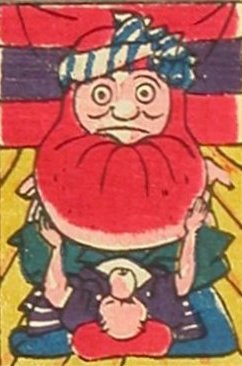
|
NOW TO ROUND THINGS OFF LET'S DISCUSS THE DARUMA |
||
|
Detail of a print of Daruma by Kuniyoshi. |
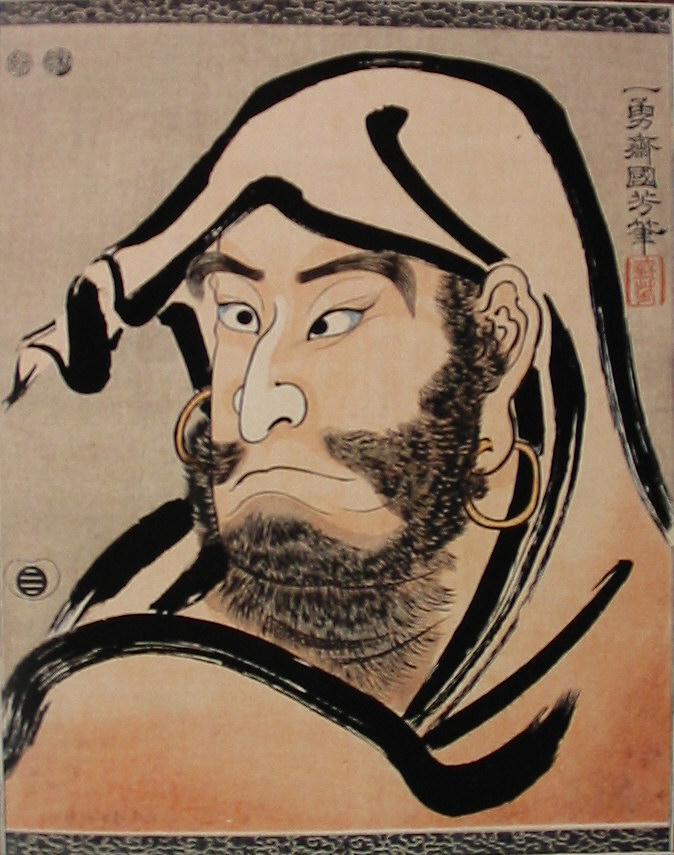 |
|
|
|
||
|
The 'historical' figure Bodhidharma is said to have been the founder of Chan Buddhism in China. In time this evolved into a Japanese form we refer to as Zen. In Japan Bodhidharma is known as the Daruma. |
||
|
NOW ON TO THE
SUSPENSION OF DISBELIEF PART
Put on your gullibility hat for this.
When Bodhidarma was over 100 years old --- or, at least, that is how I remember it --- he decided to spread his gospel to China. Accounts vary. All accounts vary. One story says that he rode a reed or blade of grass all the way there while standing erect, determined, composed. Other stories said he went by ship and it took over three years. There are numerous paintings of this reed-riding event as 'proof'. Once he arrived in China his message was not well received. In time, he went to a) meditate in a cave or b) before a wall. This meditation lasted for 9 years. Here again there are several versions of what happened during this period. In one tale Bodhidharma is said to have had difficulty staying awake. In frustration he had his eye-lids cut off and tossed aside.* Nine years of such intense concentration took their toll and his arms and legs atrophied to the point of simply dropping off. This became the origin of the roly-poly Daruma dolls which are so ubiquitous in Japanese culture. Originally they were purchased to ward off diseases such as smallpox, but in time they were metaphorically identified with other aspects of society --- in particular with prostitutes. In fact, the term 'daruma' became a euphemism for a prostitute based on the principal that like the doll no matter how many times you knocked them down they always came right back up.
*The discarded eye-lids are said to have miraculously transformed into the first green tea plants to grow in China. Also, the intensity of the Daruma's gaze in both paintings and the dolls can be accounted for by the fact that he no longer has any eye-lids. |
||
 |
||
|
Kuniyoshi seems to have set the standard for humorous tanuki images. Above is a detail of a group of tanuki painting the scrotum of a fellow tanuki in the likeness of Daruma. Look carefully and you will see the tanuki which is being painted in the center of this picture. |
||
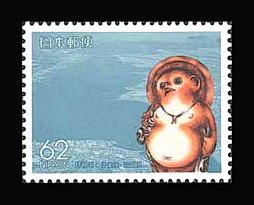 |
||
| There is a large industry dedicated to the production of ceramic tanuki. The postage stamp featured above was issued in 1999, I believe. It was not meant to draw attention to the figure itself, but to do honor to the ceramics of a particular geographic location. Anyone familiar with these statuaries would immediately know what they are looking at. They would also notice that the tanuki is only shown from the belly up. The offending body parts are discretely omitted for the sake of public decency. | ||
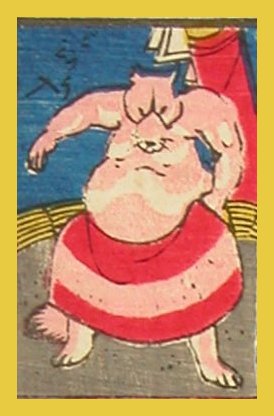
|
TANUKI USING HIS SCROTUM AS A SUMO WRESTLER'S CEREMONIAL APRON (WHY IS THERE NO FRINGE?) |
||
|
|
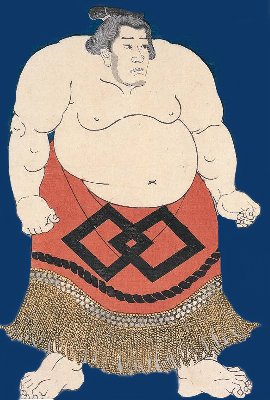 |
|
| To the left is an image by Kunisada of a sumo wrestler wearing his kesho mawashi. | ||
|
The ceremonial apron worn by the sumo (相撲 or すもう) wrestler on several occasions is referred to as a kesho mawashi (化粧回し or けしょうまわし). According to Dorothea M. Buckingham in her The Essential Guide To Sumo (Bess Press, Honolulu, 1994, pp. 106-8) this garments are made of silk brocade or nishijin ori (西陣織り or にしじんおり). "While they appear to be aprons, they are closer to a woman's obi (sash)." The first time the kesho mawashi is worn is for the entrance ceremony or dohyo iri (土俵入り or どひょう-いり) when the sekitori (関取 or せきとり), i.e., professional wrestlers, enter the ring. Novice professionals making their first appearance borrow "...a kesho mawashi from a senior stable brother. The next time he will wear one is at his ring-entrance ceremony..." Later his own personal ceremonial apron may be "...a gift from his hometown koenkai (support group)." (Koenkai is 後援会 or こうえんかい.) Now this poses our first real problem. Obviously our tanuki sumo wrestler must be a seasoned veteran because I can think of no possible way he could be wearing the scrotum of a fellow tanuki.
A DESCRIPTION OF THE KESHO MAWASHI
"The average kesho mawashi weighs twenty-two pounds and costs tens of thousands of dollars." They also were originally hemmed with gold or silver braided fringes. Now that raises the second problem: How could the tanuki use both his scrotum as a kesho mawashi and add a fringe. He couldn't. So, it lacks verisimilitude. We can overlook the missing fringe. |
||
|
|
||
 |
||
|
The detail shown above is by Kuniyoshi, the teacher of Yoshiiku. The degree of inspiration is clear. This image illustrates the dohyō-iri (土俵入り or どひょういり) or ring-entrance ceremony. There are two particularly striking, shocking even, elements to this image: One is the fact that the ceremony is being performed on the scrotum of the tanuki seated in the lower left of this picture and that ten tanuki sumo wrestlers are all using their scrota as their own kesho mawashis. Of course, they don't hold a candle to the seated one when it comes to size.
A BRIEF DESCRIPTION OF THE DOHYŌ-IRI
"This spectacular show begins with sumotori [i.e., wrestlers]...parading down the hanamichi [literally the flower part or aisle to the ring] in single file dressed in their kesho mawashis..." The lowest ranked wrestler enters first. "As they begin to enter the ring, a yobidashi (announcer) claps two wooden boards together and announces the name, home prefecture and stable..."* Part of the ceremony involves a moment when all of the wrestlers raise their kesho mawashis to show the assembled crowd that they are hiding no weapons anywhere. Not a pretty picture is it? At least, for me it isn't. I don't know about you.
*The Essential Guide to Sumo, by Dorothea N. Buckingham, published by the Bess Press, Honolulu, 1994, p. 59-60. Sumotori (相撲取り or すもうとり); hanamichi (花道 or はなみち); yobidashi (呼出し or よびだし). |
||
|
HERE'S A STUMPER FOR YOU. DON'T WORRY. THIS IS NOT DIFFICULT. |
||
|
|
||
|
A number of years ago there was a series of full-page advertisements which ran in Newsweek and Time. Displayed neatly laid out in rows were approximately forty star sapphires or diamonds. Each seemed exactly the same except there was a catch. Either all of them were artificial but one or vice versa. Memory fails me. The question posed on those pages was something like: "Can You Pick The One Gem Which Is Different." I prided myself on my ability to discern the real from the fake. Perhaps this is a false memory.
This brings me to the question I am asking you today. No tricks here. Can you tell which is the real cat below and which is the tanuki scrotum-cat. Take your time. Be sure. A lot depends on this. |
||
|
|
Another ad on TV
showed Ella Fitzgerald hitting a high note which shattered a glass. Repeated
later the announcer said: "Is it live or is it Memorex?"
I guess one just never knows for sure. Does one? |
|
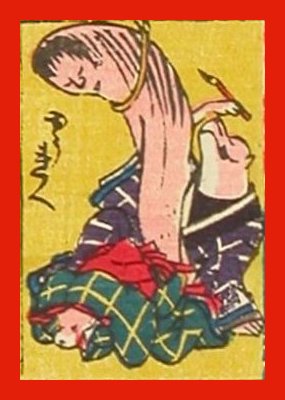
|
THE TANUKI SCROTUM AS A PAINTED GHOST |
|
|
|
There is a story about the artist Maruyama Ōkyo (1733-1795) who while painting a picture of ghost is startled when it comes to life - or death - whichever you like. Another version of the story which I heard was that the artist was painting a portrait of his dead wife when it came off the page to haunt him. This account might be as fanciful as the image itself. I don't know which is closer to the truth.
The remarkable rendition shown above appears to operate on several levels of humor. It predates an image by Yoshitoshi shown below by more than twenty years, but clearly plays on the same theme. However, the whimsy of the tanuki scrotum/ghost is accentuated by the use of the rope to hoist the prodigiously pendulous flesh while at the same time drawing attention to the humor of the artist whose upraised brush has just crudely painted a face and hair on himself much the way a child would paint on an inflated balloon.
There is another subtlety in this little image. Notice the second tanuki in the green robe lying on the ground facing away from artist/tanuki. Perhaps this is also a form of tanuki shunga or sex picture. Don't know. Just a thought. |
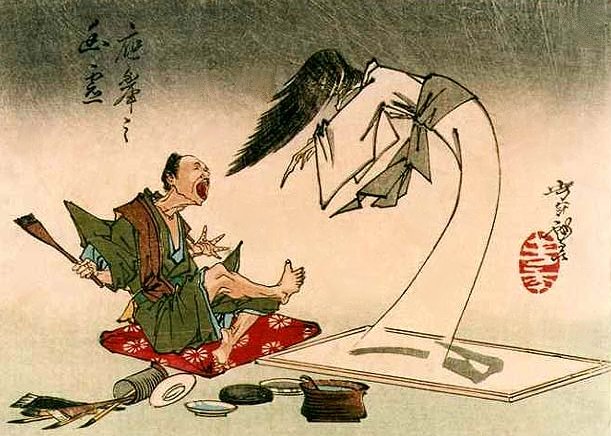 |
| The image illustrated above is from a chuban version of the tale of Ōkyo by Yoshitoshi. Years ago I sold one of these prints to a lawyer. I don't think he was a divorce lawyer, but if he had been that might have been more appropriate. |
|
THIS IS VERY IMPORTANT! INDEED IT IS! |
|
While I was looking for information on tanuki and related subjects I did a search using Copernic --- my favorite Western languages search engine --- by typing in the words catfish, gourd and Zen. As usual a huge selection lay before me. After a few hits I stumbled --- and stumbled can be the only word --- upon THE BEST informational web site I have found so far in English and that includes the material I have in my reasonably large printed library. It is by Professor Gregory Smits at Penn State University. It is not only readable and enjoyable, but in just a few short paragraphs it answered more questions I had thought about over the years than any other source I have ever found. I contacted Dr. Smits and got his kind permission to add a link to this page. DO YOURSELF A FAVOR AND READ IT BY CLICKING ON THE LINK BELOW! There is no other page like it that I am aware of. |
| http://www.east-asian-history.net/textbooks/172/ch8.htm |
 |
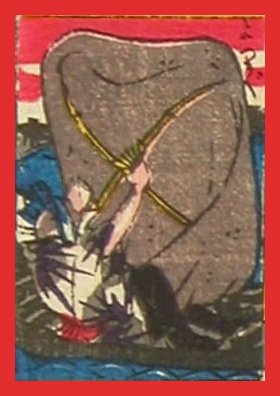 |
 |
||
| This tanuki looks like just another one of those fun loving windsurfing jocks. (My apologies to anyone who hates the term jock. Really! It is just another word: lighten up.) | ||||
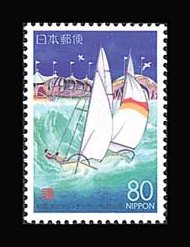 |
||||
| Above is Japanese postage stamp issued in 1994. Wish they had used a tanuki instead of a figure of a man doing the sailing, but that would be too much to expect. | ||||
 |
Can you picture going to the beach or on vacation only to encounter packs or flotillas or armadas of windsurfing tanuki? No? Well, maybe the images to the right and left would give you a better idea. Use your imagination. |
 |
||
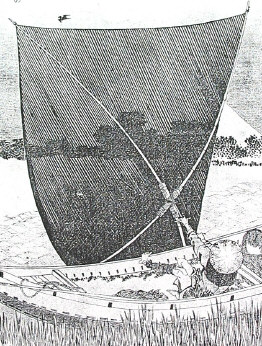 |
Yatsude-ami (四つ手網 or よつであみ) is the name of this special four-cornered scoop Japanese fishing net. | |||
| Okay! Okay! Here is a correction. The tanuki shown above is probably casting his scrotum as a fishing net like that in the detail of the Hokusai immediately above and not as a windsurfing sail. |
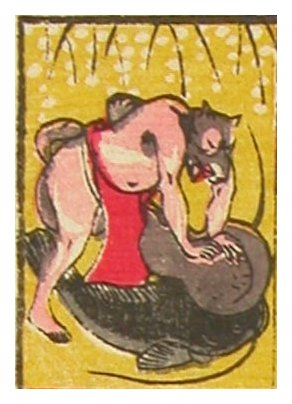
|
There is a famous Zen conundrum about how one would catch a catfish with a gourd. Here the tanuki is clubbing the giant fish with its scrotum which is displayed in the shape of a gourd.
(Note that the entry above is just the beginning. We shall add a considerable commentary and additional images on this subject. Today is October 27, 2003. Come back if you are interested.) |
||
|
鯰 |
GIANT CATFISH | なまず |
| NAMAZU | ||
| At some point the Zen concept of trying to catch a catfish with a gourd and the clubbing of the catfish with a gourd were merged or confused. I am confused. In any case, many people believed that a giant catfish was the cause of among other things earthquakes. The image to the right is from another anonymous Meiji print which we have offered. |
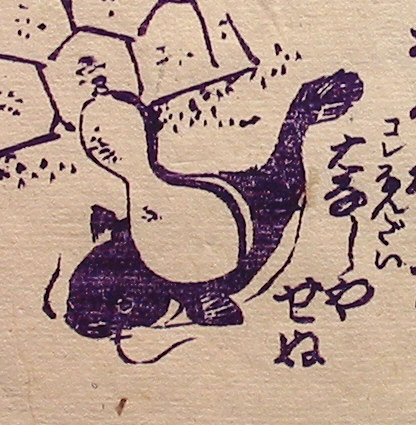 |
|
|
This particular sub, sub-genre is referred to as "Namazu gourd balls" or namazu hy˘tan kintama (鯰瓢箪金玉 or なまずひょうたんきんたま.) |
||
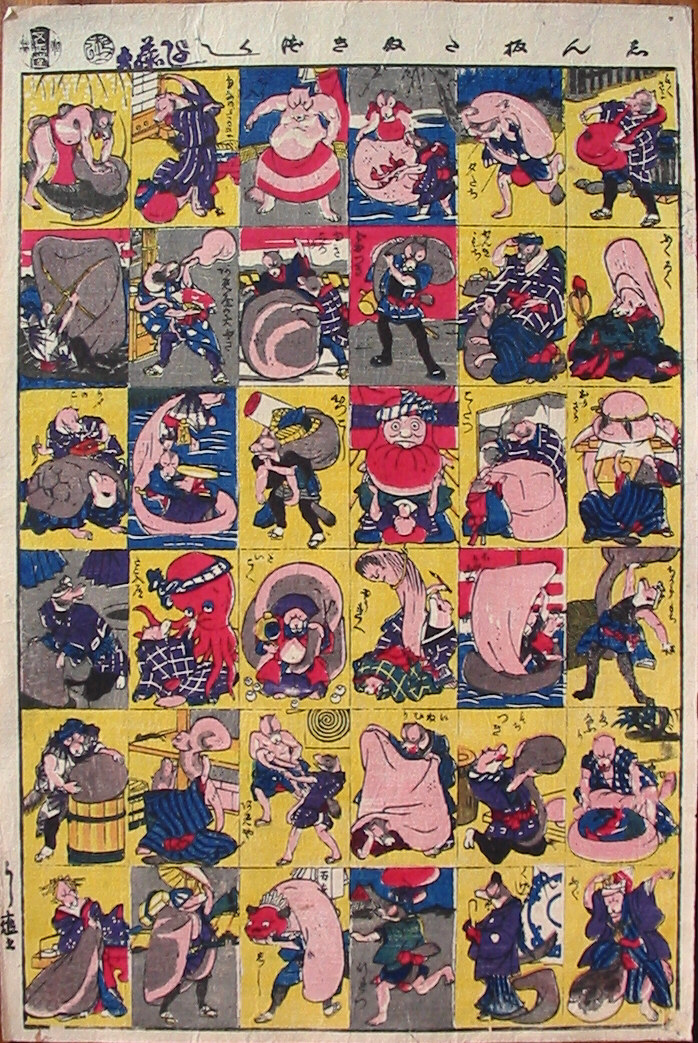
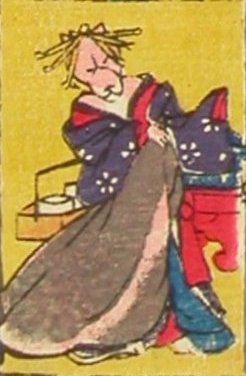

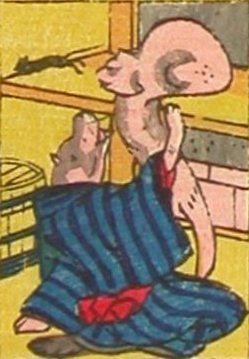
 HOME
HOME